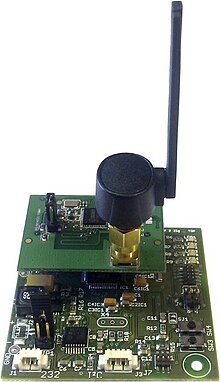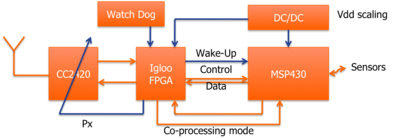150:
24:
504:
O. Berder and O. Sentieys. Powwow : Power optimized hardware/software framework for wireless motes. In Proc. of the
Workshop on Ultra-Low Power Sensor Networks (WUPS), co-located with Int. Conf. on Architecture of Computing Systems (ARCS 2010), pages 229–233, Hannover, Germany, February
468:
The first version of PowWow were released July 2009. PowWow V1 includes the motherboard, the radio board and the software. A first prototype of the coprocessing board is currently available but not yet distributed. PowWow V2 is under development.
325:
to reduce the time spent in radio reception (RX) mode. This protocol consists in cycled rendez-vous initiated by a wake-up beacon from potential receivers. Thanks to this method, nodes are sleeping most of the time, hence saving energy.
539:
Lin, E.-Y. A., Rabaey, J. M., Wolisz, A. : Power-efficient rendez-vous schemes for dense wireless sensor networks. In Proc. of the IEEE Int. Conf. on
Communications, Paris, France, June 2004.
940:
548:
M.M. Alam, O. Berder, D. Menard, T. Anger, and O. Sentieys. A hybrid model for accurate energy analysis of wsn nodes. EURASIP Journal on
Embedded Systems, 2011.
576:
946:
934:
859:
421:
PowWow software distribution provides an API organized into protocol layers (PHY, MAC, LINK, NET and APP). The software is based on the
904:
515:
864:
569:
968:
562:
869:
92:
292:
AGL125: 130 nm, 125 kgates, 32 kbits on-chip RAM, 1 kbits Flash, PLL for clock management.
227:, data authentication, clear channel assessment, link quality indication and packet timing information
879:
727:
770:
702:
429:, which provides a sequential control flow without complex state machines or full multi-threading.
103:
17:
631:
585:
453:
237:
35:
236:
A co-processing board can be added to the motherboard on P1, P2 connectors. This board provides
910:
651:
241:
851:
760:
681:
473:
348:
Next node for hop transmission is chosen in the neighbors as the nearest to the destination
65:
8:
921:
519:
355:
298:
Power consumption: 2.2 uW, 16 uW, 1 to 30 mW in sleep, freeze, run modes
220:
64:. Unlike other available mote systems, PowWow offers specific features for a very-high
785:
330:
143:
84:
54:
973:
926:
894:
608:
593:
80:
722:
302:
224:
198:
135:
88:
433:
Memory efficiency: 6 Kbytes (protocol layers) + 5 Kbytes (application)
142:
such as the radio transceiver board, the coprocessing board and some sensor and
826:
139:
99:
61:
962:
671:
666:
740:
172:
554:
34:(Power Optimized Hardware and Software FrameWork for Wireless Motes) is a
422:
322:
216:
131:
38:
76:
is based on an asynchronous rendezvous scheme initiated by the receiver,
874:
692:
941:
International
Conference on Information Processing in Sensor Networks
884:
798:
676:
162:
79:
architectural and circuit level optimizations were performed such as
73:
831:
818:
803:
201:
178:
330uA at 1 MHz and 2.2 V in active mode, 1.1uA in standby mode
149:
793:
775:
712:
661:
641:
626:
621:
603:
485:
426:
107:
841:
750:
745:
636:
613:
367:
Neighbors are discovered at power-up and on regular time period
58:
50:
836:
717:
707:
687:
287:
46:
42:
394:
Direct transmission to a specific neighbors with/without ACK
808:
735:
697:
16:
This article is about the sensor mote. For other uses, see
305:
for link layer implemented on the FPGA consumes 5 mW
210:
Spreading gain of 9 dB, data rate of 250 kbit/s
106:
and is currently derived from the
Protothread library of
23:
447:
436:
Over-the-air re-programmation (and soon reconfiguration)
402:
Multi-hop transmission to a specific node in the network
339:
PowWow uses a simple geographical routing protocol.
244:to increase the energy efficiency of the network.
364:A neighbor is a node in the radio range of a node
960:
476:and open source software under the GPL license.
207:Single-chip 2.4 GHz IEEE 802.15.4 compliant
947:Conference on Embedded Networked Sensor Systems
935:European Conference on Wireless Sensor Networks
386:Broadcast a packet to all network nodes, no ACK
251:Low-Power Programmable Timer for Wake-up period
570:
259:Dynamic Voltage and Frequency Scaling (DFVS)
584:
577:
563:
378:Direct transmission to {neighbors}, no ACK
130:PowWow hardware platform is composed of a
156:
905:Ad hoc On-Demand Distance Vector Routing
148:
22:
321:PowWow uses RICER protocol proposed by
961:
231:
215:Hardware support for packet handling,
558:
317:MAC layer: preamble sampling protocol
168:MSP430F1612 version, 8 MHz clock
49:. The platform is currently based on
440:
102:is very light (5 kbytes) uses
13:
14:
985:
479:
463:
345:Each node has (x,y) coordinates
181:P1, P2 connectors for extension
41:developed by the Cairn team of
870:Sensor network query processor
542:
533:
508:
498:
268:8 MHz divided by 1 to 128
188:
184:JTAG, RS232 and I2C interfaces
1:
459:Energy estimation methodology
311:
273:Programmable DC/DC converter
36:wireless sensor network (WSN)
391:Direct Hop with/without ACK
248:Power Mode Management (PMM)
95:co-processing for low power,
7:
456:for MSP430 is also possible
416:
114:
10:
990:
491:
472:PowWow is delivered as an
361:Neighbor table management
295:Supply voltages 0 to 1.65V
286:Low-power Igloo FPGA from
175:, 5 KB of on-chip RAM
15:
920:
893:
880:Wireless powerline sensor
850:
817:
784:
759:
650:
592:
194:TI CC2420 RF transceiver
165:low-power microcontroller
703:Near-field communication
197:Digital direct sequence
104:event-driven programming
27:PowWow hardware platform
18:pow wow (disambiguation)
969:Wireless sensor network
586:Wireless sensor network
238:dynamic voltage scaling
911:Dynamic Source Routing
448:IAR Embedded Workbench
157:Processing motherboard
153:
28:
242:hardware acceleration
152:
26:
682:Bluetooth Low Energy
474:open-source hardware
405:Each hop is with ACK
335:Geographical routing
134:including an MSP430
865:Location estimation
446:Currently based on
372:Transmission modes
283:FPGA co-processing
262:Programmable Clock
232:Co-processing Board
221:burst transmissions
356:Euclidean distance
154:
29:
956:
955:
516:"PowWow Hardware"
441:Development Tools
408:Uses node address
399:Robust Multi-Hop
331:Multi-hop routing
276:TPS62402/TPS61030
66:energy efficiency
55:radio transceiver
981:
860:Key distribution
609:ERIKA Enterprise
579:
572:
565:
556:
555:
549:
546:
540:
537:
531:
530:
528:
527:
518:. Archived from
512:
506:
502:
486:Official website
354:in the sense of
144:energy harvester
127:
126:
122:
81:power management
989:
988:
984:
983:
982:
980:
979:
978:
959:
958:
957:
952:
925:
916:
896:
889:
846:
813:
780:
762:
755:
653:
646:
595:
588:
583:
553:
552:
547:
543:
538:
534:
525:
523:
514:
513:
509:
503:
499:
494:
482:
466:
452:Compiling with
443:
419:
314:
303:Viterbi decoder
234:
225:data encryption
199:spread spectrum
191:
159:
140:daughter boards
136:microcontroller
128:
124:
120:
118:
117:
89:voltage scaling
21:
12:
11:
5:
987:
977:
976:
971:
954:
953:
951:
950:
944:
938:
931:
929:
918:
917:
915:
914:
908:
901:
899:
891:
890:
888:
887:
882:
877:
872:
867:
862:
856:
854:
848:
847:
845:
844:
839:
834:
829:
823:
821:
815:
814:
812:
811:
806:
801:
796:
790:
788:
782:
781:
779:
778:
773:
767:
765:
757:
756:
754:
753:
748:
743:
738:
733:
730:
725:
720:
715:
710:
705:
700:
695:
690:
685:
679:
674:
669:
664:
658:
656:
652:Communications
648:
647:
645:
644:
639:
634:
629:
624:
619:
616:
611:
606:
600:
598:
590:
589:
582:
581:
574:
567:
559:
551:
550:
541:
532:
507:
496:
495:
493:
490:
489:
488:
481:
480:External links
478:
465:
462:
461:
460:
457:
450:
442:
439:
438:
437:
434:
418:
415:
414:
413:
412:
411:
410:
409:
406:
403:
397:
396:
395:
389:
388:
387:
381:
380:
379:
370:
369:
368:
365:
352:
351:
350:
349:
346:
337:
336:
333:
319:
318:
313:
310:
309:
308:
307:
306:
299:
296:
293:
290:
281:
280:
279:
278:
277:
271:
270:
269:
266:
265:LTC6930, 490uA
257:
256:
255:
252:
233:
230:
229:
228:
217:data buffering
213:
212:
211:
208:
205:
190:
187:
186:
185:
182:
179:
176:
171:55 KB of
169:
166:
158:
155:
116:
113:
112:
111:
100:software stack
96:
77:
62:microprocessor
9:
6:
4:
3:
2:
986:
975:
972:
970:
967:
966:
964:
948:
945:
942:
939:
936:
933:
932:
930:
928:
923:
919:
912:
909:
906:
903:
902:
900:
898:
892:
886:
883:
881:
878:
876:
873:
871:
868:
866:
863:
861:
858:
857:
855:
853:
849:
843:
842:TinyDB-TOSSIM
840:
838:
835:
833:
830:
828:
825:
824:
822:
820:
816:
810:
807:
805:
802:
800:
797:
795:
792:
791:
789:
787:
783:
777:
774:
772:
769:
768:
766:
764:
758:
752:
749:
747:
744:
742:
739:
737:
734:
731:
729:
726:
724:
721:
719:
716:
714:
711:
709:
706:
704:
701:
699:
696:
694:
691:
689:
686:
683:
680:
678:
675:
673:
670:
668:
667:IEEE 802.15.4
665:
663:
660:
659:
657:
655:
649:
643:
640:
638:
635:
633:
630:
628:
625:
623:
620:
617:
615:
612:
610:
607:
605:
602:
601:
599:
597:
591:
587:
580:
575:
573:
568:
566:
561:
560:
557:
545:
536:
522:on 2011-08-25
521:
517:
511:
501:
497:
487:
484:
483:
477:
475:
470:
458:
455:
451:
449:
445:
444:
435:
432:
431:
430:
428:
424:
407:
404:
401:
400:
398:
393:
392:
390:
385:
384:
382:
377:
376:
374:
373:
371:
366:
363:
362:
360:
359:
358:
357:
347:
344:
343:
342:
341:
340:
334:
332:
329:
328:
327:
324:
316:
315:
304:
300:
297:
294:
291:
289:
285:
284:
282:
275:
274:
272:
267:
264:
263:
261:
260:
258:
253:
250:
249:
247:
246:
245:
243:
239:
226:
222:
218:
214:
209:
206:
203:
200:
196:
195:
193:
192:
183:
180:
177:
174:
170:
167:
164:
161:
160:
151:
147:
145:
141:
138:and of other
137:
133:
123:
109:
105:
101:
97:
94:
90:
86:
82:
78:
75:
71:
70:
69:
67:
63:
60:
56:
52:
51:IEEE 802.15.4
48:
44:
40:
37:
33:
25:
19:
852:Applications
741:WirelessHART
544:
535:
524:. Retrieved
520:the original
510:
500:
471:
467:
464:Availability
420:
353:
338:
320:
254:MAX6370, 8uA
235:
173:flash memory
129:
31:
30:
922:Conferences
761:Programming
425:library of
423:protothread
323:UC Berkeley
189:Radio Board
132:motherboard
963:Categories
875:Sensor web
693:ISA100.11a
526:2011-03-26
375:Broadcast
312:Networking
57:and on an
897:protocols
885:Telemetry
799:Iris Mote
763:languages
677:Bluetooth
654:protocols
618:NanoQplus
594:Operating
383:Flooding
163:TI MSP430
146:boards.
85:frequency
74:MAC layer
53:standard
949:(SenSys)
927:journals
832:LinuxMCE
819:Software
804:Sun SPOT
786:Hardware
723:Sidewalk
684:(Wibree)
417:Software
202:baseband
115:Hardware
974:Sensors
895:Routing
794:Arduino
776:LabVIEW
732:TIBUMAC
713:One-Net
662:6LoWPAN
642:OpenWSN
627:OpenTag
622:Nano-RK
604:Contiki
596:systems
492:Sources
427:Contiki
108:Contiki
943:(IPSN)
937:(EWSN)
907:(AODV)
751:Z-Wave
746:Zigbee
728:Thread
637:TinyOS
614:LiteOS
119:": -->
59:MSP430
32:PowWow
913:(DSR)
837:OPNET
718:OSIAN
708:OCARI
688:DASH7
505:2010.
301:e.g.
288:Actel
204:modem
47:INRIA
43:IRISA
827:NS-2
809:XBee
736:TSMP
698:MiWi
632:RIOT
240:and
121:edit
98:the
93:FPGA
91:and
87:and
72:the
39:mote
672:ANT
454:gcc
965::
223:,
219:,
83:,
68::
924:,
771:C
578:e
571:t
564:v
529:.
125:]
110:.
45:/
20:.
Text is available under the Creative Commons Attribution-ShareAlike License. Additional terms may apply.

